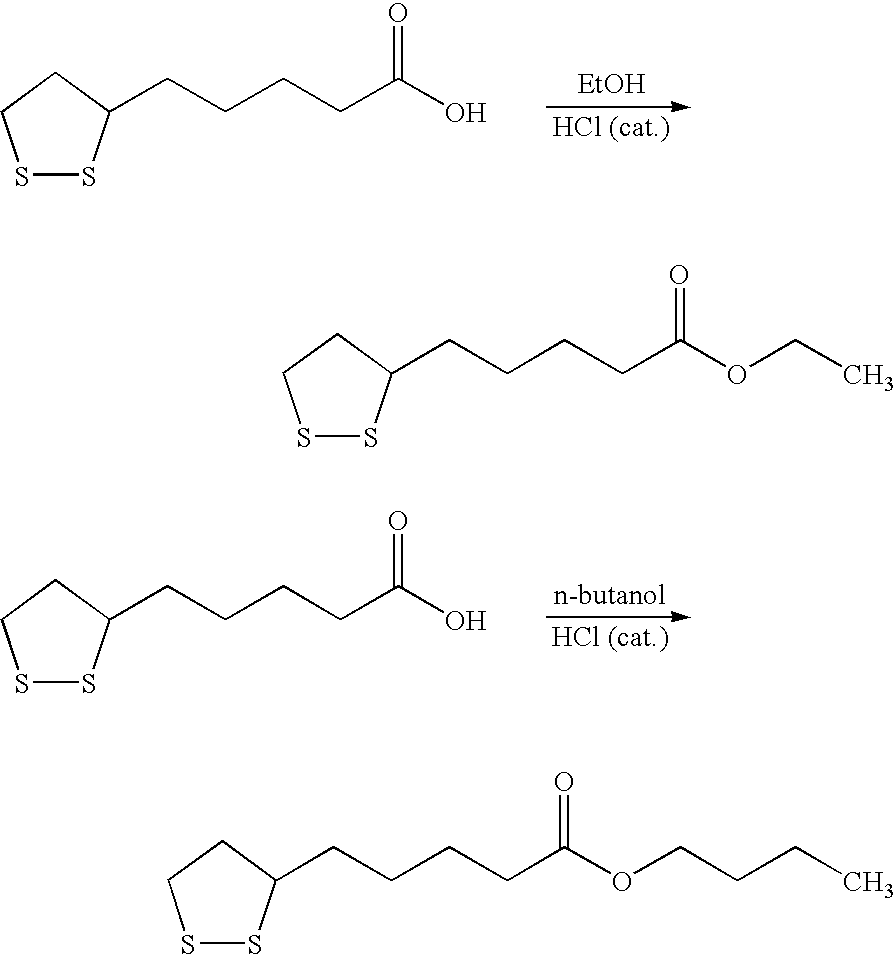Novel esters of lipoic acid
a technology of lipoic acid and esters, which is applied in the field of processes for the production of thioctic acid/lipoic acid esters, can solve the problems of reducing the yield of the synthesis procedure and the tendency of lipoic acid to polymeriz
- Summary
- Abstract
- Description
- Claims
- Application Information
AI Technical Summary
Problems solved by technology
Method used
Image
Examples
example 1
Preparation of Lipoic Acid Ethyl Ester—100 g Scale
[0015] In a 2-L flask, was added absolute ethanol (1 L) followed by acetyl chloride (5.2 mL). The mixture was stirred for 2 hours. Lipoic acid (100.0 g) was added and stirred at room temperature overnight.
[0016] The reaction was quenched with the addition of solid sodium bicarbonate (25 g) and stirred for 4 h. The heterogeneous mixture was filtered through celite and L-cysteine (1 g) added. The solution was concentrated under reduced pressure while keeping the temperature less than 20° C. The resulting yellow oil was stored at ≦−5° C.
example 2
Preparation of Lipoic Acid Butyl Ester—100 g Scale
[0017] In a 2-L flask, was added n-butanol (1 L) followed by acetyl chloride (5.2 mL). The mixture was stirred for 2 hours. To the stirring mixture was added L-cysteine (1 g) and stirring continued for 20 min. Lipoic acid (100.0 g) was added and stirred at room temperature overnight.
[0018] The reaction was quenched with the addition of solid sodium bicarbonate (25 g) and stirred for 4 h. The heterogeneous mixture was filtered through celite and L-cysteine (1 g) added. The solution was concentrated under reduced pressure while keeping the temperature less than 20° C. The resulting yellow oil was stored at ≦−5° C.
example 3
Preparation of Lipoic Acid Octadecyl Ester—5 g Scale
[0019] Lipoic acid (5.0 g) was dissolved in anhydrous THF (100 mL). The stirring solution was cooled to 0° C. and triethylamine (3.7 mL) added. The cold reaction was stirred 10 min and ethyl chloroformate (2.6 mL) added slowly. The reaction was stirred at 0 C for 20 min then 1-octadecanol (6.9 g) was added. After stirring for 20 min the cooling bath was removed and the reaction stirred to room temperature overnight. A solution of 5% citric acid (75 mL) was added and the mixture stirred for 10 min then the two phases separated. The organic layer was washed with saturated sodium bicarbonate, brine and dried over sodium sulfate. After filtration of the solids, cysteine ethyl ester (100 mg) was added and the volatiles removed under reduced pressure at less than 20 C. The waxy solid was stored at ≦−5° C.
PUM
 Login to View More
Login to View More Abstract
Description
Claims
Application Information
 Login to View More
Login to View More - R&D
- Intellectual Property
- Life Sciences
- Materials
- Tech Scout
- Unparalleled Data Quality
- Higher Quality Content
- 60% Fewer Hallucinations
Browse by: Latest US Patents, China's latest patents, Technical Efficacy Thesaurus, Application Domain, Technology Topic, Popular Technical Reports.
© 2025 PatSnap. All rights reserved.Legal|Privacy policy|Modern Slavery Act Transparency Statement|Sitemap|About US| Contact US: help@patsnap.com



